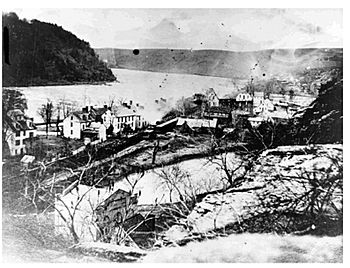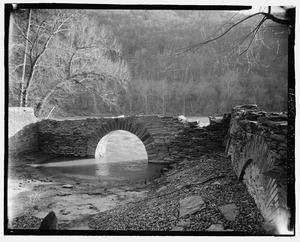Virginius Island, West Virginia facts for kids

Virginius Island in 1864, seen from Jefferson Rock. Note the train and roofless building near the center.
|
|
| Geography | |
|---|---|
| Location | Shenandoah River, West Virginia, United States |
| Coordinates | 39°19′17″N 77°44′21″W / 39.3214898°N 77.7391595°W |
| Administration | |
Virginius Island is a small island in the Shenandoah River in Harpers Ferry, West Virginia. It's about 12 acres in size. This island was created between 1806 and 1807. Workers built the Shenandoah Canal to help boats avoid fast-moving water. The canal also directed water to power machines.
In the 1800s, Virginius Island was a busy place. It had many factories and homes for workers. Today, Virginius Island is part of the Harpers Ferry National Historical Park.
Contents
What Made Virginius Island a Busy Place?
Virginius Island was a very active industrial area in the early 1800s. The Shenandoah River provided strong water power for machines. It was easy to get goods to markets using the Potomac River.
Things got even better when the Winchester and Potomac Railroad arrived in 1836. This train line ran right through the island. Today, trains still use these tracks daily. The Baltimore and Ohio Railroad came a year later. This connected Harpers Ferry to Baltimore and Washington, D.C.
Industries and Life on the Island
Over time, many different businesses operated on the island. There was a cotton mill and a flour mill, which lasted the longest. Other businesses included a sawmill and an iron foundry. There was also a tannery, a rifle factory, and a machine shop. A cooperage made barrels for the flour mill. A carriage shop built vehicles.
At its busiest in 1850, about 180 people lived on the island. They lived in around twenty houses.
How the Civil War Changed Virginius Island
The American Civil War (1861–1865) caused great damage to Virginius Island. The rifle factory was destroyed. Some of the mills were also ruined. The Harpers Ferry Armory, a major employer, was also destroyed. Many people left Harpers Ferry because it was not safe.
During much of the war, Union soldiers used the island. They set up barracks and stables there. It also served as a hospital and a place for storage.
What Happened to Virginius Island?
After the Civil War, industry on the island did not fully recover. New factories used steam power instead of water power. This meant they could be built anywhere, not just by rivers. A pulp mill was the biggest business during this time.
In 1936, a huge flood hit the Harpers Ferry area. It was the worst flood ever recorded. The people still living on Virginius Island had to leave. They never returned. All the buildings on the island were destroyed.
Virginius Island Today
Today, you can see the remains of the old mills and factories. You can also see where homes once stood. The National Park Service has worked to protect these ruins. They have also added signs to explain what you are seeing.
Another flood in 1996 closed the island to visitors. It reopened in 2003. People say that the remaining structures are now strong enough to resist more floods.
Experts have studied the history of Virginius Island. They learned about the daily lives of the people who lived there. They also studied how water-powered machines changed over time.


